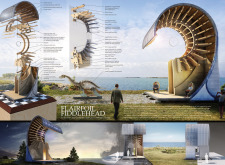5 key facts about this project
At its core, the pavilion embodies the concept of organic architecture, drawing inspiration from the intricate shapes of fiddlehead ferns and seashells. This notion is reflected in the pavilion’s gentle curves which mimic natural growth patterns. The design allows for a dynamic interaction with the site, encouraging users to appreciate their surroundings from various vantage points. The pavilion’s exterior gracefully blends with the coastal landscape, while the interior offers a warm and inviting atmosphere.
The architectural design cleverly incorporates materials such as Cross-Laminated Timber and Glue-Laminated Timber, both of which highlight sustainable building practices. The combination of these materials not only ensures structural integrity but also promotes a reduced environmental impact. Cross-Laminated Timber offers the dual benefits of strength and stability, which are essential for modern construction, while Glue-Laminated Timber allows for the creation of the pavilion's curved forms. Additionally, the use of glass elements enhances the connection between the interior and exterior spaces, flooding the structure with natural light and providing unobstructed views of the surrounding landscape.
Key components of the pavilion include well-defined seating areas that facilitate various activities, observation platforms that encourage nature appreciation, and flexible spaces adaptable for different community functions. The strategic layout maximizes usability while maintaining a sense of openness and comfort. The distinctive spiral form of the pavilion not only acts as a visual focal point but also serves to elevate the user's experience, making each visit feel unique.
In designing the Flairfoil Fiddlehead, the architects have employed unique approaches that prioritize environmental sustainability and user engagement. The integration of natural materials reflects a commitment to ecological responsibility, and the design philosophy fosters a harmonious relationship between the architecture and its context. This pavilion transcends merely serving a functional purpose; it embodies a living space where architecture and nature coexist harmoniously.
The project serves as an example of how thoughtful architectural design can enhance community interaction while promoting environmental consciousness. By incorporating advanced construction techniques and an awareness of local ecology, it creates a meaningful space that resonates with users on multiple levels.
For those interested in delving deeper into the architectural plans, sections, and various design elements of the Flairfoil Fiddlehead Pavilion, further exploration of the project presentation is encouraged. This project is not only a reflection of innovative architectural ideas but also an invitation to engage with nature in a thoughtfully constructed setting.























